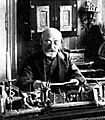Ludovic Lazarus Zamenhof facts for kids
Quick facts for kids
Ludovic Lazarus Zamenhof
|
|
|---|---|

Ludwik Lejzer Zamenhof, 1908
|
|
| Born |
Leyzer Leyvi Zamengov
December 15, 1859 |
| Died | April 14, 1917 (aged 57) |
| Nationality | Polish |
| Known for | Creator of Esperanto |
| Signature | |
Ludovic Lazarus Zamenhof (born December 15, 1859 – died April 14, 1917) was an eye doctor and a smart person. He is famous for creating Esperanto, an international language.
Zamenhof was born in 1859 in Białystok, a town in Poland. At that time, Poland was part of the Russian Empire. Białystok had different groups of people living there. These included Poles, Belorussians, and Jewish people who spoke Yiddish. Zamenhof believed that if everyone spoke one common language, it would help them get along better and stop arguments.
Contents
A Gift for Languages
Zamenhof grew up speaking many languages. His first language was likely Polish. His parents spoke Russian and Yiddish at home. His father was a German teacher, so Zamenhof learned German very early. He spoke it perfectly.
Later, he learned French, Latin, Greek, Hebrew, and English. He was also interested in Italian, Spanish, and Lithuanian. This love for languages helped him create Esperanto.
Creating Esperanto
Zamenhof wanted to create an international language that was easy to learn. He thought it should have simple grammar. This would make it much simpler than other invented languages like Volapük. He worked hard to make Esperanto's rules clear and easy to follow.
The basic ideas for Esperanto were published in 1887. His goal was to help people from different backgrounds communicate easily.
Later Life and Recognition
Zamenhof's grandson, Louis-Christophe Zaleski-Zamenhof, has lived in France since the 1960s.
Zamenhof was nominated for the Nobel Peace Prize many times. He received 14 nominations between 1907 and 1917. This shows how important his work was seen by others.
Images for kids
-
Zamenhof at his desk in his Warsaw apartment, 1910
See also
 In Spanish: L. L. Zamenhof para niños
In Spanish: L. L. Zamenhof para niños





